Key takeaways:
- Beer bottle conditioning adds complexity to flavors by using a small amount of sugar and yeast before sealing, resulting in unique and evolving taste experiences over time.
- Craft beer festivals create a sense of community, offering opportunities to connect with brewers, discover new favorites, and deepen appreciation for the brewing process through shared stories.
- Exploring diverse craft beer styles enhances the drinking experience, allowing for unexpected flavors and personal revelations about taste preferences.
- Successful bottle conditioning requires careful attention to priming sugar amounts, consistent storage temperature, and patience during the aging process for optimal results.
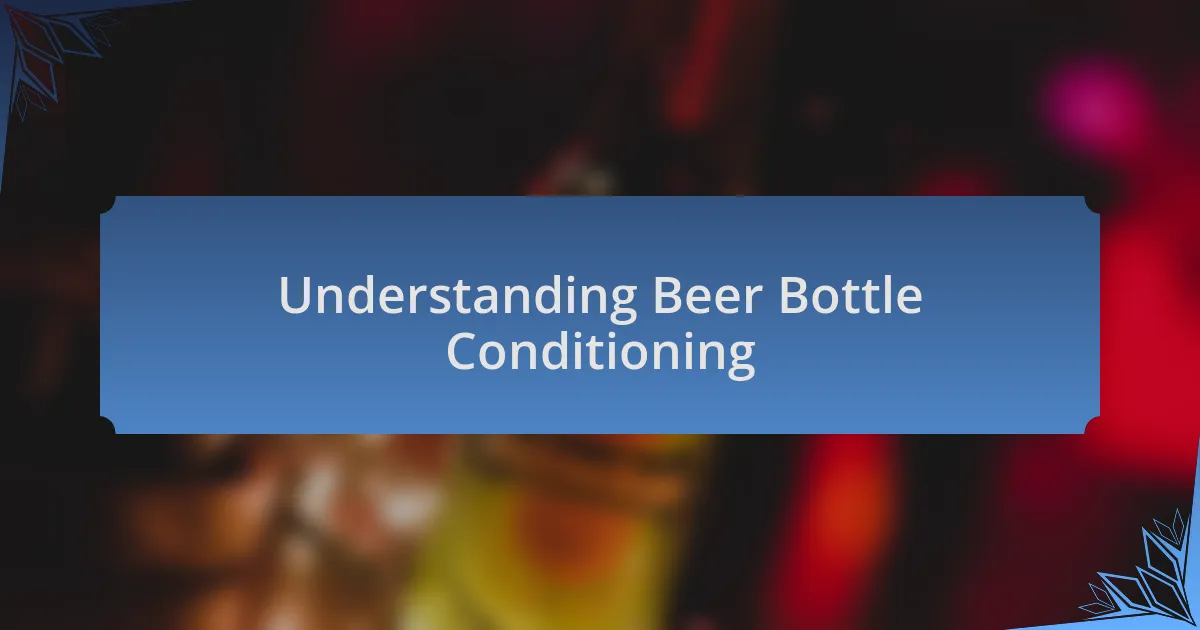
Understanding Beer Bottle Conditioning
When I first encountered the concept of beer bottle conditioning, it felt like uncovering a hidden treasure in the craft beer world. Essentially, this process involves adding a small amount of sugar and yeast to the beer just before sealing it in the bottle. I remember the excitement I felt watching the bubbles dance in the bottle as fermentation kicked in, knowing that this step would add a layer of complexity to the flavors.
Bottle conditioning isn’t just a technical process; it’s like nurturing a living entity. I’ve seen how the flavors develop over time, often leading to a more rounded taste that can be surprisingly different from the beer’s initial state. Have you ever tasted a freshly bottled beer versus one that has been aged for a few months? The transformation can be quite extraordinary, and I still find it a thrill to experience that evolution.
As I’ve learned more about this practice, I’ve come to appreciate its artistry. Each bottle tells its own story, shaped by the yeast and the conditions in which it lives. It’s this unpredictability that makes the journey of exploring bottle-conditioned beers so engaging—there’s always the potential for delightful surprises hidden within each sip.
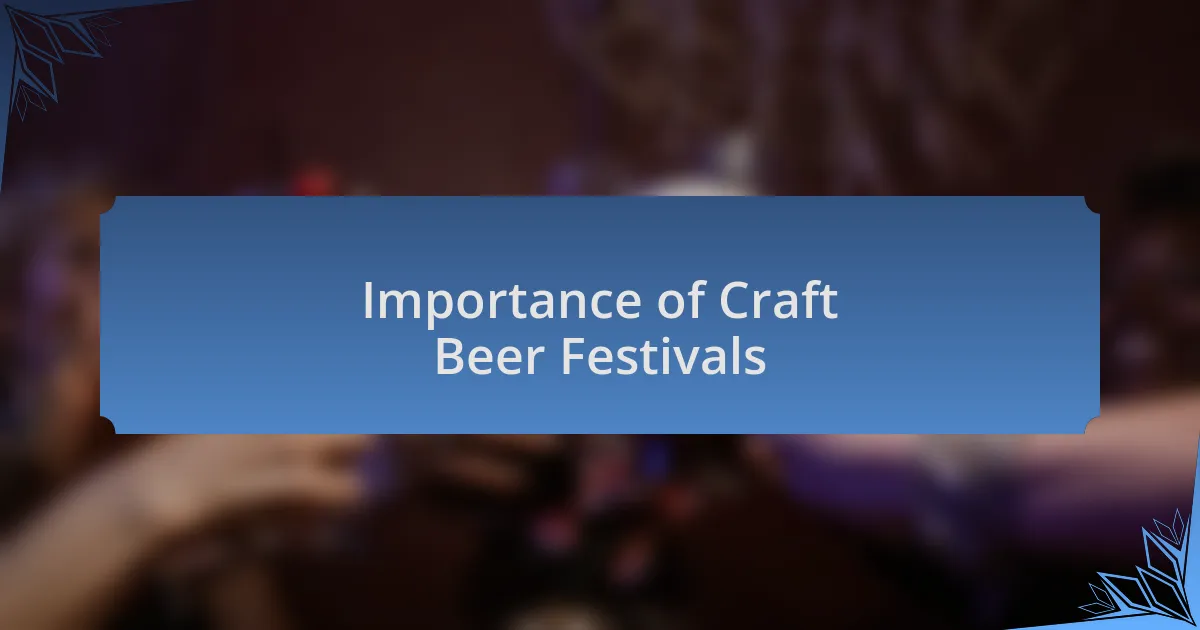
Importance of Craft Beer Festivals
Attending craft beer festivals is more than just tasting unique brews; it’s about building a community. I still remember my first festival; the camaraderie among fellow beer lovers made me feel instantly connected to something bigger. Have you ever found a new favorite beer because of a passionate brewer sharing their story? Those personal connections and conversations are what make these events truly memorable and special.
Moreover, craft beer festivals provide an invaluable platform for local breweries to shine. During one festival, I had the chance to try a limited-release beer from a tiny brewery that had just a few taps. It was thrilling to see them gain recognition through the event, and it made me realize how vital these festivals are for fostering innovation and creativity in the brewing industry.
Lastly, craft beer festivals serve as an educational experience for attendees. I remember attending a workshop at one event where they explained the intricacies of hops. It deepened my appreciation for the craft beer-making process, and I walked away eager to explore different styles more intentionally. Isn’t it empowering to learn directly from the experts while tasting their creations? It transforms the experience from mere consumption into a deeper understanding and appreciation of what goes into each brew.
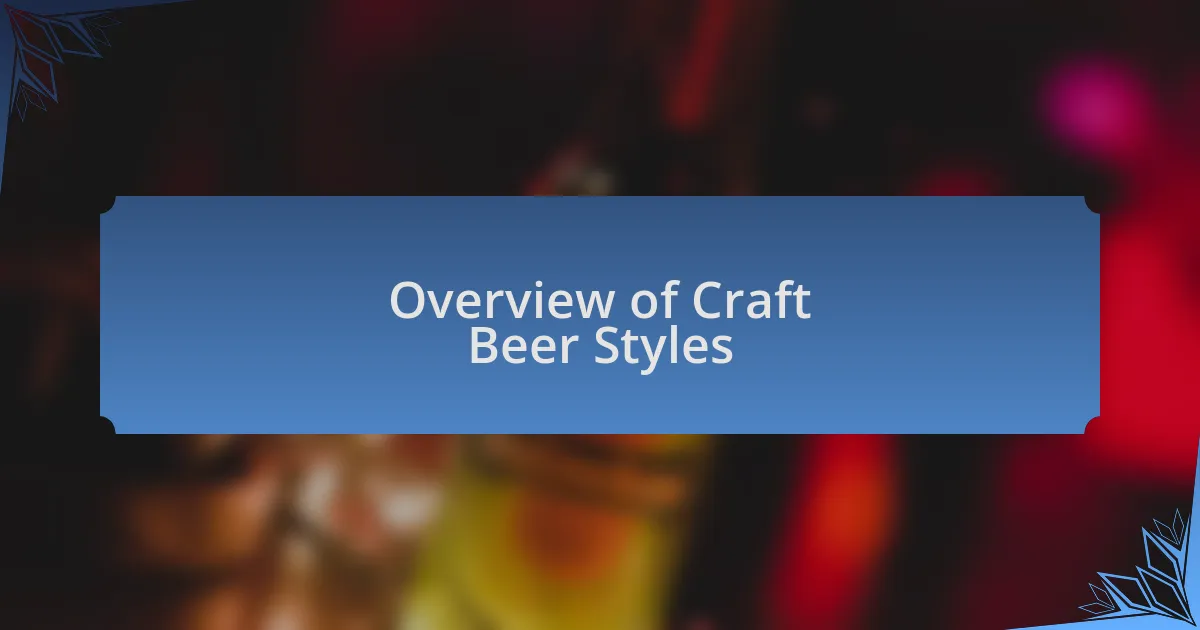
Overview of Craft Beer Styles
Craft beer styles are as diverse as the brewers who create them. From hoppy IPAs that burst with citrus flavors to rich stouts boasting notes of chocolate and coffee, there’s a world of flavors waiting to be discovered. I remember sipping a Belgian Dubbel for the first time; the complexity of its maltiness had me reflecting on the artistry behind each carefully chosen ingredient. Have you ever come across a brew that left you in awe, pondering how something could taste so expertly crafted?
Each style not only represents different ingredients and methods but also reflects the unique culture of its origin. Take lagers, for instance; their crisp, clean profiles can transport you straight to a sunny biergarten in Germany. I still cherish the moment when a friend introduced me to a local craft lager that captured that spirit. It’s fascinating how these beers can evoke memories and transport you to different places without ever leaving your chair.
Exploring craft beer styles can be an adventure all on its own, filled with surprises at every turn. During a tasting session, I stumbled upon a sour ale that tingled on my tongue, a flavor profile I hadn’t expected to enjoy. It made me realize how experimenting with new styles can broaden one’s palate. Have you ever felt that excitement when uncovering a style you never knew you’d love? Each sip can challenge our expectations and push the boundaries of what we think we know about beer.
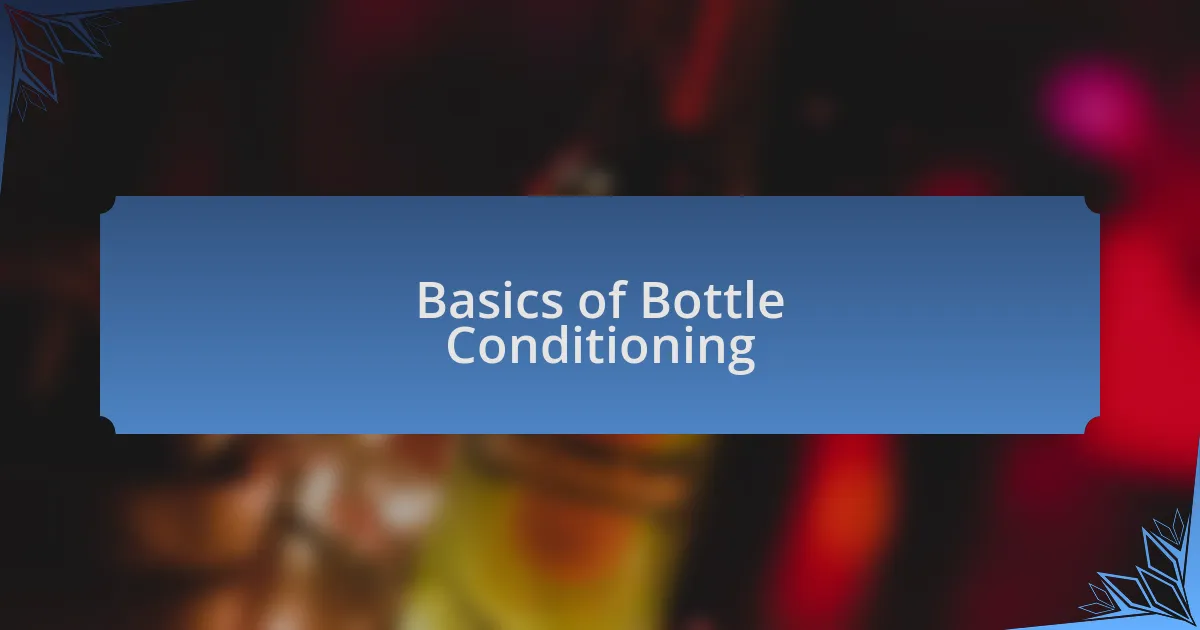
Basics of Bottle Conditioning
Bottle conditioning is a fascinating process that involves adding a small amount of sugar and yeast to beer before sealing it in bottles. This method not only carbonates the beer through natural fermentation but also enhances its flavors over time. I distinctly remember the first time I tried a bottle-conditioned beer; the effervescence felt alive, and the layers of taste continued to evolve with each sip, making it an unforgettable experience.
As the yeast consumes the added sugar, it produces carbon dioxide, which gets trapped in the sealed bottle, creating bubbles that dance on your palate. I’ve often wondered how some beers manage to balance complexity and smoothness so seamlessly. It’s that sparkle from bottle conditioning that makes a beer feel celebratory, almost like you’re savoring a special occasion with every pour.
One of the beautiful aspects of bottle conditioning is that it allows beers to mature. I’ve had the pleasure of revisiting bottles that I stashed away for months—or even years—and opening them felt like revisiting an old friend. The anticipation of discovering how the flavors unfolded over time never fails to excite me. Have you ever saved a special bottle, eager to see how it transformed? That moment of revelation when you finally take a sip is what makes bottle conditioning truly worthwhile.
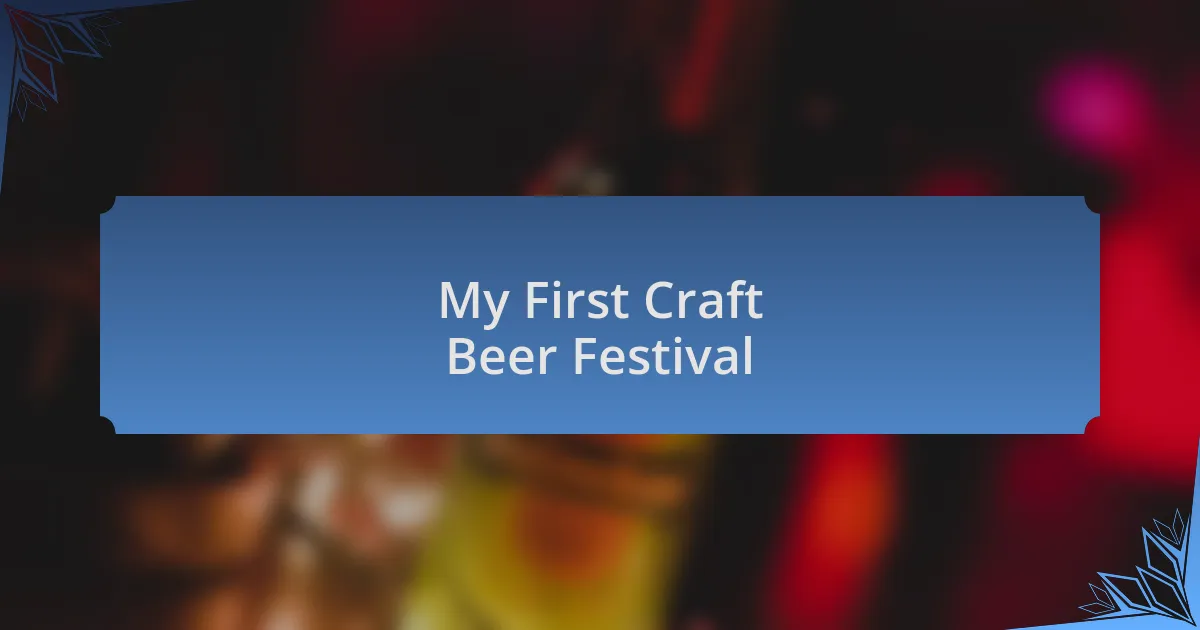
My First Craft Beer Festival
The first time I stepped into a craft beer festival, I was overwhelmed by the vibrant energy around me. The air was thick with the enticing aromas of hops and malt, and I felt like a kid in a candy store, excited to explore countless unique brews. As I navigated through the bustling crowds, I distinctly remember my heart racing at the thought of trying so many different flavors, each representing a small piece of the brewer’s creativity.
One particular moment stands out. I came across a booth featuring a local brewery known for its bottle-conditioned ales. As I sampled their offerings, a rich, complex flavor danced across my palate, reminiscent of a warm autumn evening. It sparked a delightful memory of enjoying cozy nights with friends, showcasing the emotional connection between beer and shared experiences. Have you ever sampled a brew that instantly transported you back to a cherished moment? That’s the magic of craft beer festivals—they amplify not just taste but the stories we carry with us.
Amid the eclectic conversations and laughter, I also realized how each pour represented a labor of love. Listening to brewers share their journeys was inspiring; they spoke passionately about their craft, and you could see the pride in their eyes. It made me appreciate the artistry behind each bottle. It was a powerful reminder that craft beer is not just a drink; it’s a celebration of community, creativity, and shared moments.

Learning from Festival Experiences
As I participated in my first craft beer festival, I quickly learned that each booth offers more than just a taste; it unfolds a story. One especially captivating discussion with a brewer revealed how their dedication to sustainability shaped their brewing process. It made me reflect: how often do we consider the broader impacts of our favorite beverages? These conversations deepened my appreciation for the craft and transformed my festival experience into a journey of discovery.
Navigating through the festival, I noticed that some people were drawn to familiar names while others ventured into unknown territories. I remember sharing a table with a couple who were trying their first sour beer, their surprise evident when they discovered a flavor profile they didn’t expect. It struck me how festivals encourage exploration—not just of beer but of our own palates. Each sip became a chance to challenge our preferences and expand our horizons. Have you ever found a new favorite by taking that leap?
One of my most memorable lessons came from engaging with fellow festival-goers. I found myself in a lively discussion about barrel aging—how oak can transform beer’s character. Sharing tips and experiences with strangers ignited a sense of camaraderie that I hadn’t fully anticipated. It wasn’t just about the beer; it was about connections and shared passions. Reflecting on that moment, I wondered: what if our beer journeys brought us closer together? That’s the essence of craft beer festivals—they’re where friendships can blossom over a shared love for brewing.

Tips for Successful Bottle Conditioning
When it comes to bottle conditioning, precision is key. From my own experience, using the right priming sugar is crucial for achieving that perfect carbonation level. I remember when I initially experimented, I miscalculated my amounts, resulting in overly fizzy beer that didn’t quite hit the mark. Have you ever had a brew that popped more than it poured? That’s a common mistake that can easily be avoided with careful measurements.
Temperature plays a significant role during the conditioning process. Ideally, I’ve found keeping bottles at a consistent temperature around 70°F (21°C) creates the best environment for the yeast to work its magic. I’ve had batches where I moved them to cooler spots, thinking it would slow down the process, only to end up with flat beer. Have you thought about where you store your bottles? Finding the right spot can turn a mediocre batch into a delightful one.
Finally, patience is essential. The first time I rushed the process, expecting instant results, I got an underwhelming product. I’ve learned to let my bottles condition for at least two to four weeks—sometimes even longer for certain styles. Have you ever had the pleasure of opening a well-aged beer? There’s a definite thrill in waiting, knowing the flavors will develop and improve over time. The reward is well worth the wait!